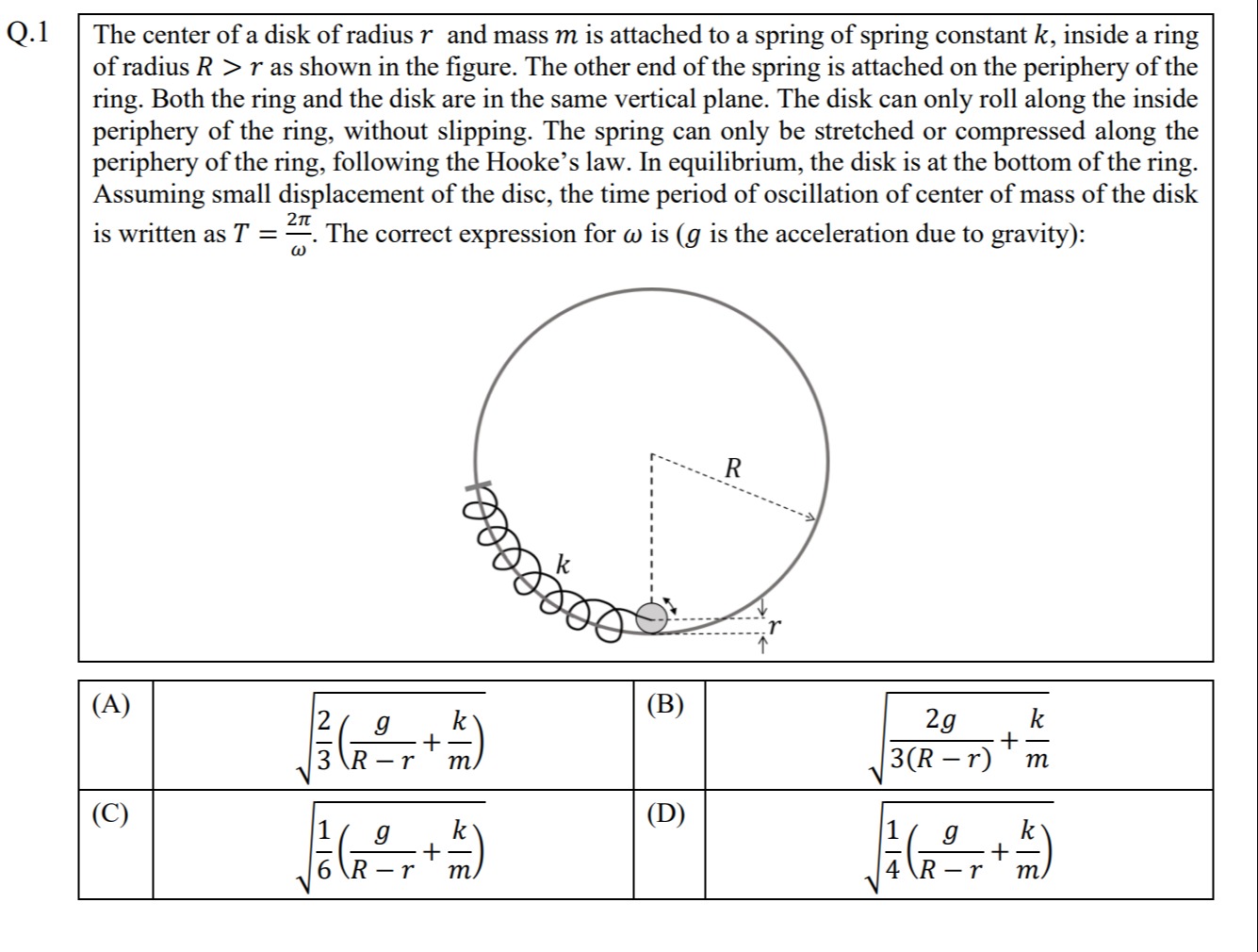Question
Question: The center of a disk of radius $r$ and mass $m$ is attached to a spring of spring constant $k$, insi...
The center of a disk of radius r and mass m is attached to a spring of spring constant k, inside a ring of radius R>r as shown in the figure. The other end of the spring is attached on the periphery of the ring. Both the ring and the disk are in the same vertical plane. The disk can only roll along the inside periphery of the ring, without slipping. The spring can only be stretched or compressed along the periphery of the ring, following the Hooke's law. In equilibrium, the disk is at the bottom of the ring. Assuming small displacement of the disc, the time period of oscillation of center of mass of the disk is written as T=ω2π. The correct expression for ω is (g is the acceleration due to gravity):

32(R−rg+mk)
3(R−r)2g+mk
61(R−rg+mk)
41(R−rg+mk)
32(R−rg+mk)
Solution
The problem asks for the angular frequency ω of small oscillations of a disk rolling without slipping inside a larger ring, attached to a spring. We will use the energy method to find the equation of motion for small oscillations.
1. Define Coordinates and Displacement:
Let the center of the large ring be the origin. The radius of the large ring is R, and the radius of the disk is r. The center of mass (CM) of the disk moves along a circle of radius (R−r).
Let θ be the angular displacement of the disk's CM from the equilibrium position (bottom of the ring).
The arc length traversed by the CM of the disk is x=(R−r)θ.
The velocity of the CM is vCM=x˙=(R−r)θ˙.
2. Potential Energy:
-
Gravitational Potential Energy (Ug):
Let the potential energy at the equilibrium position be zero. When the disk is displaced by an angle θ, its CM rises by a height h.
h=(R−r)−(R−r)cosθ=(R−r)(1−cosθ).
For small oscillations, we use the approximation 1−cosθ≈2θ2.
So, Ug=mgh=mg(R−r)2θ2. -
Spring Potential Energy (Us):
The spring is attached to the center of the disk and extends along the periphery of the ring. Thus, the extension or compression of the spring is equal to the arc length covered by the disk's CM.
The extension of the spring is ΔL=x=(R−r)θ.
Us=21k(ΔL)2=21k((R−r)θ)2.
3. Kinetic Energy (K):
The disk is rolling without slipping, so its total kinetic energy is the sum of its translational and rotational kinetic energies.
-
Translational Kinetic Energy (Kt):
Kt=21mvCM2=21m((R−r)θ˙)2. -
Rotational Kinetic Energy (Kr):
For rolling without slipping, vCM=rωdisk, where ωdisk is the angular velocity of the disk about its own center.
So, ωdisk=rvCM=r(R−r)θ˙.
The moment of inertia of a disk about its center is I=21mr2.
Kr=21Iωdisk2=21(21mr2)(r(R−r)θ˙)2=41m(R−r)2θ˙2. -
Total Kinetic Energy (K):
K=Kt+Kr=21m(R−r)2θ˙2+41m(R−r)2θ˙2=(21+41)m(R−r)2θ˙2=43m(R−r)2θ˙2.
4. Total Energy and Equation of Motion:
The total mechanical energy of the system is E=Ug+Us+K.
E=mg(R−r)2θ2+21k(R−r)2θ2+43m(R−r)2θ˙2.
Since energy is conserved, dtdE=0.
Differentiating E with respect to time t:
dtdE=mg(R−r)θθ˙+k(R−r)2θθ˙+43m(R−r)2(2θ˙θ¨)=0.
Assuming θ˙=0 (for oscillating motion), we can divide the equation by θ˙:
mg(R−r)θ+k(R−r)2θ+23m(R−r)2θ¨=0.
Rearrange the equation into the standard form for Simple Harmonic Motion (SHM), θ¨+ω2θ=0:
23m(R−r)2θ¨+[mg(R−r)+k(R−r)2]θ=0.
θ¨+23m(R−r)2mg(R−r)+k(R−r)2θ=0.
From this, we can identify ω2:
ω2=23m(R−r)2mg(R−r)+k(R−r)2.
Factor out (R−r) from the numerator:
ω2=23m(R−r)2(R−r)[mg+k(R−r)].
Simplify by canceling (R−r) and rearranging the constants:
ω2=3m(R−r)2[mg+k(R−r)].
Distribute the denominator:
ω2=32(m(R−r)mg+m(R−r)k(R−r)).
ω2=32(R−rg+mk).
Finally, take the square root to find ω:
ω=32(R−rg+mk).
